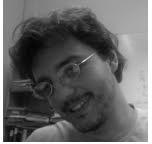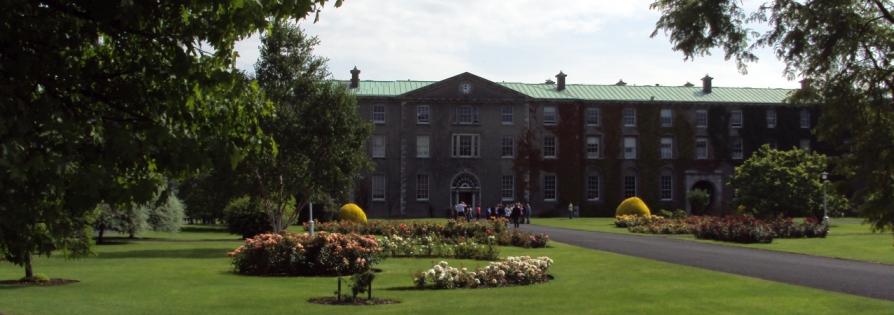Public Lecture
Time: Thursday, May 26, 2016, 17:30
Place: Iontas Theatre, Iontas Building, Maynooth University North
Campus.

Mauro Paternostro
Quantumness in a classical world?
Quantum mechanics is helping us to build a new technological paradigm. Novel and exciting possibilities, such as teleportation and quantum computing, are offered by the quantum based management of information and communication. However, the quantum advantages seem to be prerogatives of only microscopic, relatively simple systems. In this talk I will argue that this is not necessarily the case, and strong quantum features should be visible even in seemingly unfavourable situations. This talk will draw the roadmap towards the observation of quantumness in an otherwise mundane, classical world.
Conference Talks
Place: Science Lecture Theatre, Callan Building, Maynooth University North
Campus.
Times: see the Conference Programme
Sarp Akcay
Gravitational-wave Astronomy
I will give a brief background on the physics of gravitational waves followed by a discussion on the detection science. I will then provide some details on the recent gravitational-wave discovery of September 14, 2015. I will conclude by mentioning the near-future prospects for gravitational wave astronomy.
Marc Casals
Quantum dress for a naked singularity
We investigate semiclassical backreaction on a conical naked singularity space-time with a negative cosmological constant in (2+1)-dimensions. In particular, we calculate the renormalized quantum stress-energy tensor for a conformally coupled scalar field on such naked singularity space-time. We then obtain the backreacted metric via the semiclassical Einstein equations. We show that, at least formally, semiclassical backreaction dresses the naked singularity with an event horizon. Finally, on a similar but different setting, we obtain the semiclassical backreaction on a rotating BTZ black hole space-time and study its properties.
Michael Duff
Twin supergravities from Yang-Mills squared
We consider so-called twin supergravities - pairs of supergravities with N+ and N- supersymmetries, N+ > N., with identical bosonic sectors - in the context of tensoring super Yang-Mills multiplets. A possible classification from topological arguments as well as their relation to squaring is given.
Mikael Fremling
Laughlin's State and the Plasma Analogy
The Laughlin wave function is the drosophila of representative trial wave functions for the fractional quantum Hall effect, describing e.g. the filling fraction ν=1/3. In this talk I will discuss the connection between Laughlin's wave function and the partition function of a two dimensional one component plasma. I will focus on the properties of this wave function when it has periodic boundary conditions (i.e. is on a torus). On the torus, modular transformations put strong constraints on the analytic structure that the wave functions can have, and also cast light on the type of anyon braiding that is present for the quasi-particles. It also turns out that if one of the torus' perimeters is sufficiently short -- i.e. approaching the thin-torus limit -- the Laughlin plasma fails to screen, which has consequences for the anyonic braiding.
Margarita Garcia Pérez
Reducing the volume in Yang-Mills theories
We will discuss the interplay between volume and group degrees of freedom in Yang-Mills theory. In the limit of infinite number of colours this has led to the concept of volume independence through Eguchi-Kawai reduction. We will review some attempts to extend this idea beyond the large N limit. A few non-perturbative examples will be shown, including the running of the SU(N) .t Hooft coupling and the 2+1 dimensional glueball spectrum.
Philipp Haehnel
Conformal Higher Spin Theories and Twistor Actions
Based on arXiv:1604.08209, we consider the twistor description of conformal higher spin theories and give twistor space actions for the self-dual sector of theories with spin greater than two that produce the correct flat space-time spectrum. We identify a ghost-free subsector, analogous to the embedding of Einstein gravity with cosmological constant in Weyl gravity, which generates the unique spin-s three-point anti-MHV amplitude consistent with Poincaré invariance and helicity constraints. By including interactions between the infinite tower of higher-spin fields we give a geometric interpretation to the twistor equations of motion as the integrability condition for a holomorphic structure on an infinite jet bundle.
Masud Haque
Dynamics and thermalization in isolated quantum systems
Quantum many-body physics has traditionally been focused on equilibrium
properties and low-energy excitations. Only in recent years is
the study of quantum matter far from equilibrium emerging as a new field.
In the absence of external mechanisms for reaching equilibrium,
the behavior of an isolated quantum system poses many new challenges to
our understanding of quantum matter.
I will present an overview of some dynamical phenomena in isolated quantum
systems, focusing on the question of whether an isolated system
can thermalize in some sense.
Ben Hörz
Scattering amplitudes from Lattice QCD
We present results for the resonant pion-pion scattering amplitude and the timelike pion form factor obtained from numerical simulations of QCD in Euclidean time. Algorithmic advancements in the treatment of quark propagation enable the precise extraction of these quantities and will be discussed briefly.
Manuela Kulaxizi
Constraints on the CFT three point functions
We discuss methods to analytically obtain constraints on the OPE coefficients of an arbitrary CFT (in d>3 dimensions). One of them is the positivity of the energy flux; another one involves deep inelastic scattering thought experiments. We derive bounds on the OPE coefficients of various operator using both methods. We discuss under which conditions the constraints derived are equivalent .
Niall Moran
Parafermionic clock models and quantum resonance
A signature of non-Abelian topological phases of matter is a ground
state degeneracy that is immune to local perturbations. Many models
exhibiting non-Abelian topological order also feature strong zero modes,
which implies that all states of the system (not just the ground state)
are degenerate. While zero modes are not strictly necessary for
topological order, their presence can make systems more resilient to
diffusive dynamics and hint at the possibility of stable topological
phases at finite temperature.
In this talk I introduce a family of 1D quantum clock models and discuss
the presence of strong zero modes. These models exhibit a
ZN symmetry which leads to N distinct symmetry
sectors. The N=2 case is the well known Majorana chain where it is known
that strong zero modes exist. I argue that for N>2, there are no
strong zero modes, except at certain special high-symmetry points.
However, for odd N, there are regimes where weaker zero modes
may persist. This is shown by examining processes which lead to
sub-exponential splitting of the degeneracy. These processes can only
occur at resonance points, where bands of excited states cross.
Thus by studying the distribution and nature of resonance points, it is
possible to extrapolate the behaviour in the thermodynamic limit.
Ciara Morgan
Ultimate limits for quantum communication
Establishing the optimal communication rate at which information can be
reliably transmitted over noisy quantum channels is a question of central
importance in quantum information theory. The achievability, or direct
part, of a channel coding theorem, establishes a rate of communication
below which the decoding error tends to zero in the limit of large block
length. This raises the natural question of whether a larger rate can be
achieved with a non-zero decoding error. In other words, the question of
whether an error-rate trade-off is possible emerges. The strong converse
theorem addresses this question and when established for a particular
channel, confirms that there can be no such error-rate trade-off for that
channel. The question of whether a strong converse theorem holds for all
quantum channels remains open.
In this talk the above concepts will be introduced and ongoing efforts
towards attacking this open problem will be reported.
Ronan McNulty
New Physics hints through precision tests of the Standard Model
Precise tests of the Standard Model are sensitive to New Physics, either directly produced at the LHC or present in loops. I will discuss the status of single and double Electroweak boson production as well as Higgs branching fractions, mass and width. Hints of anomalous behaviour in lepton universality tests, W pair production, and the recent di-photon excess at 750 GeV will be reviewed.
Sergey Mozgovoy
TBA
David Pérez-Garcia
Undecidability of the spectral gap
The spectral gap.the energy difference between the ground state and first excited state.is central to quantum many-body physics. Many challenging open problems, such as the Haldane conjecture, existence of gapped topological spin liquid phases, or the Yang-Mills conjecture, concern spectral gaps. These and other problems are particular cases of the general spectral gap problem: given a quantum many-body Hamiltonian, is it gapped or gapless? In this work, we prove that the spectral gap problem is undecidable. We construct families of quantum spin systems on a 2D lattice with translationally-invariant, nearest-neighbour interactions for which this is an undecidable problem. This result extends to undecidability of other low energy properties, such as existence of algebraically decaying ground-state correlations. The proof combines Hamiltonian complexity techniques with aperiodic tilings, to construct a Hamiltonian whose ground state encodes the evolution of a quantum phase-estimation algorithm followed by a universal Turing Machine. The spectral gap depends on the outcome of the corresponding Halting Problem. Our result implies that there exists no algorithm to determine whether an arbitrary model is gapped or gapless. It also implies that there exist models for which the presence or absence of a spectral gap is not defined by the axioms of mathematics.
Andreas Ruschhaupt
Creating exotic angular momentum states by shaking an optical lattice
We propose a method to create higher orbital states of ultracold atoms in the Mott regime of an optical lattice. This is done by periodically modulating the position of the trap minima (known as shaking) and controlling the interference term of the lasers creating the lattice. These methods are combined with techniques of shortcuts to adiabaticity. As an example of this, we show specifically how to create an anti-ferromagnetic type ordering of angular momentum states of atoms. The specific pulse sequences are designed using Lewis-Riesenfeld invariants and a four-level model for each well. The results are compared with numerical simulations of the full Schroedinger equation.
Kareljan Schoutens
Non-abelian anyons in 2+1 dimensions
Quantum physics in 2+1 dimensions allows for the spectacular possibility of non-Abelian braid statistics. It arises when a topological quantum material is such that a small number of excitations, at fixed position, give rise to a degenerate space of states, and when the braiding of such excitations is represented as a matrix acting on the state vector. The patterns of fusion and braiding of excitations (`anyons¹) in bosonic 2D systems with non-Abelian statistics are captured by the mathematical notion of a modular tensor category (MTC). We present recent results, obtained with X.-G. Wen, on the classification and construction of MTC¹s with a limited number (up to N=6) of anyon-types.
Stefan Sint (for the ALPHA collaboration)
On the accuracy of perturbation theory in QCD
A collaborative effort to determine the strong coupling αs(mZ) from low energy hadronic input (such as the pion and kaon masses or life times) is nearing completion. The only method able to systematically address this problem is lattice QCD and the main challenge then consists in the resolution of the large scale differences involved. I will explain the overall strategy and then focus on the running of the coupling at high energies where we can confront non-perturbative continuum extrapolated data with renormalized perturbation theory. The available scales cover 2 orders of magnitude, so that we can assess the attainable accuracy of perturbation theory in QCD.
